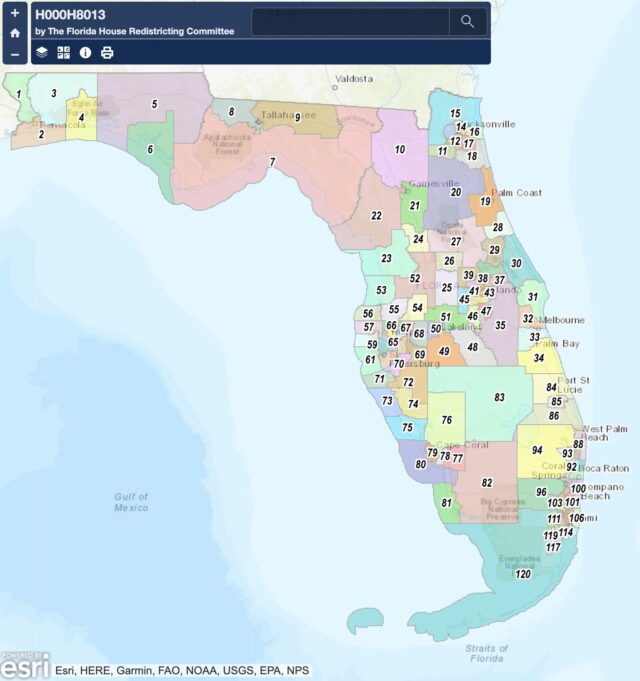
The Florida House voted 77-39 in favor of new boundaries for 120 state House districts. The new lines are expected to govern the 2022 election cycle and races for the next 10 years.
But hours of debate preceding the vote likely set up legal proceedings that could play out for months before candidates qualify for the current election cycle.
The final map (H 8013) was first published on Jan. 24 and has not been altered since the House Redistricting Committee passed it two days later. Democrats have complained about a secretive drafting process that produced just four drafts of House districts over several months, but also never offered an alternative map or any amendments along the way.
“If you can point to a line on that map or a district on that map and tell us what’s wrong with it, where have you been?” said Rep. Tom Leek, an Ormond Beach Republican and chair of the House Redistricting Committee. “These maps are good maps, they’re legal maps and they’re constitutionally compliant maps.”
In the end, the final map passed off the House floor in a largely party-line vote. A bill (SJR 100) now returns to the Florida Senate, which already passed its own map covering 40 Senate districts. The legislation includes both a House and Senate map.
As a joint resolution, it will go into effect without the involvement of the Governor. But the legislation still must pass muster with the Florida Supreme Court, which this week opened a case file in anticipation of filings regarding the legislative maps.
The court will embark on a high-level review of the map and has 30 days to determine if the products are lawful. Leek said passage of the map this early means the court should be done before Session ends, and the Legislature can address any concerns before running into overtime.
The map as it stands brings significant political consequences to the House’s current membership, including placing 19 incumbent representatives in the same districts as colleagues within the chamber. That’s a list that includes Republican Rep. Daniel Perez and Democratic Rep. Fentrice Driskell. Either could become House Speaker in 2024, depending on which party holds a majority.
Two lawmakers, Republican Rep. Mike Caruso and Democratic Rep. Christopher Benjamin, have already stated they intend to move to other districts to run.
A partisan analysis of the proposed House map shows 71 House districts where more voters supported Republican Donald Trump in the 2020 presidential election and 49 where voters favored Democrat Joe Biden. By comparison, Trump carried 73 of the existing districts and Biden won 47.
The current House makeup includes 78 Republicans and 41 Democrats, with one vacancy in a Democrat-leaning seat.
Of course, the Fair Districts amendment in Florida’s constitution forbids consideration of whether a map aids or hurts parties or incumbents. Much of the debate on the floor rather focused on whether the cartography does enough to protect minority access and the ability or racial and language minorities to elect representatives of their choice.
Rep. Geraldine Thompson, a Windermere Democrat, said the House remained too focused on avoiding diminishment as opposed to seeing how many minority districts Florida’s current population warrants. The new maps have 30 such districts, 18 Black performing districts and 12 Hispanic ones. But critics contend population growth among Florida Latinos warrants much more.
“We should not be bound by a quota,” Thompson said.
Rep. Randy Fine, a Palm Bay Republican, pushed back and said Democrats sought something the math doesn’t warrant. He noted Florida’s Black and Hispanic populations went up 15% and 35% respectively, but that shouldn’t warrant a similar increase in seats. It should be noted that’s not what any parties sought.
He said the important statistic is actually percentage of overall population, and Black residents make up almost the exact same share, about 17% of all Floridians. Hispanics have grown from 23% to 26% of the total population. That growth doesn’t necessarily warrant new seats, Fine argued, and focused on the location of that growth. Much of the Hispanic growth occurred in Osceola County, he noted, where there is now a new Hispanic-performing district.
The total number of minority seats did not change because South Florida had a district that no longer can be considered as effectively controlled by Hispanic voters.
Rep. Dotie Joseph, a North Miami Democrat, countered that even using Fine’s math, that could still demand a growth in seats. She noted with each House seat representing roughly 180,000 residents (ideal population is 179,485), that could mean several new Hispanic seats should be on the map. She also suggested the House erred in never seeking research on racially polarized voting, which could provide more information for such policy decisions than the political performance evaluations done only on minority access seats on the new map.
Democrats also raised a number of objections about what they considered a less than transparent map-drafting process. Rep. Joe Geller, the ranking Democrat on the House Redistricting Committee, said policy decisions were being made by leadership working directly with staff, and some of it apparently involved seeking legal counsel that all House members were not privy to hear.
Geller also felt particularly frustrated so many process questions went unheeded during floor debate on Tuesday.
“By our count, 36 times we didn’t get answers” on process questions, Geller said. “Sometimes we were told our questions could only relate to the maps. Sometimes told questions had been asked and answered. I agree on most of those, the question was asked.”
Of course, Republican members felt otherwise and defended the maps. Several suggested Democrats had as much access to staff as Republicans during the cartography process, but did not take advantage. “I had questions and I got answers,” said Rep. Jenna Persons-Mulicka, a Fort Myers Republican.




